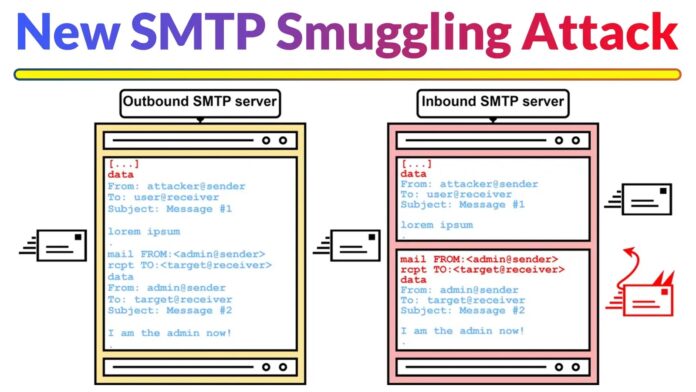[ad_1]
SMTP (Simple Mail Transfer Protocol) smuggling is a technique where attackers exploit the inconsistencies in how proxy servers or firewalls analyze and handle the SMTP traffic.
Threat actors can smuggle malicious payloads or evade detection by exploiting these inconsistencies.
This complete process makes it difficult for security systems to accurately diagnose the email transfer process, leading to potential security vulnerabilities.
In collaboration with SEC Consult, Timo Longin unveiled a new SMTP exploitation technique named SMTP smuggling.
Vulnerable servers globally can be exploited for phishing attacks by sending malicious emails from any address.
Besides this, multiple 0-day flaws were found, and vendors were already notified in a 2023 responsible disclosure.
New SMTP Smuggling Attack
SMTP protocol interpretation differences enable SMTP smuggling, sending spoofed emails while passing SPF checks.
There are two types of SMTP smuggling were discovered, and we have mentioned them:-
This allows spoofing from various domains to major SMTP servers. Microsoft and GMX fixed vulnerabilities, but SEC Consult urges manual updates for Cisco Secure Email users.
MUA (Mail user agent) connects to Outlook’s MTA (Mail transfer agent) via TCP/587. After that, a series of SMTP commands are sent; Outlook SMTP evaluates permission, then sends an inbound email to the receiver’s SMTP server via TCP/25, bypassing:-
Inbound SMTP servers verify sender authenticity using SPF, DKIM, and DMARC to prevent arbitrary domain emails. SPF relies on DNS records for sender IP permission, and the failure results in non-forwarding or spam marking.
However, SPF checks only the MAIL FROM domain, not the arbitrary value in the From header, which poses a limitation.
DKIM signs message data, including the From header, verified by the receiver with a public key in DNS.
But it doesn’t enforce the key’s domain. DMARC introduces identifier alignment by checking if the “From” domain aligns with SPF and/or DKIM.
The policy (p=) specifies the rejection of messages failing DMARC, ensuring acceptance only with valid SPF or DKIM.
Email providers used
Here below, we have mentioned all the email providers that are used:-
- outlook.com
- gmail.com
- gmx.net
- icloud.com
- zoho.com
- fastmail.com
- runbox.com
- startmail.com
- mailbox.org
- aol.com
- yahoo.com
- web.de
Analyzing outbound SMTP servers revealed an anomaly in Microsoft Outlook’s (outlook.com) server. Sending <LF>.<LF> sequence results in non-transmission, triggering an error message:-
- “550 5.6.11 SMTPSEND.BareLinefeedsAreIllegal; message contains bare linefeeds, which cannot be sent via DATA and receiving system does not support BDAT”
Unlike GMX, Outlook doesn’t filter <LF>.<CR><LF> sequences. Smuggling to certain receivers is blocked due to Outlook’s use of the optional BDAT SMTP command, an alternative to DATA, specifying message length without relying on an end-of-data sequence.
Due to negligent outbound server sanitization, SMTP smuggling is possible in GMX and Exchange Online.
Investigating insecure inbound SMTP servers, a scanner tests for permissiveness with exotic end-of-data sequences. While here, a timeout indicates the server ignored the unconventional sequence.
Research uncovered exotic inbound SMTP servers interpreting end-of-data sequences like <CR><LF>\x00.<CR><LF> (null byte represented by “\x00”).
Despite prompt patches by Microsoft and GMX, inbound SMTP smuggling to default-configured Cisco Secure Email instances remains possible. Changing these configurations is strongly advised.
Timeline
[ad_2]
Source link
